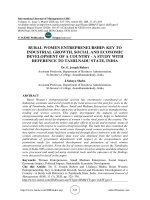Economic growth and economic development 82
Bạn đang xem bản rút gọn của tài liệu. Xem và tải ngay bản đầy đủ của tài liệu tại đây (86.36 KB, 1 trang )
Introduction to Modern Economic Growth
2.4.2. The Fundamental Equation of the Solow Model in Continuous
Time. We can now repeat all of the analysis so far using the continuous time
representation. Nothing has changed on the production side, so we continue to have
(2.5) and (2.6) as the factor prices, but now these refer to instantaneous rental rates
(i.e., w (t) is the flow of wages that the worker receives for an instant etc.).
Savings are again given by
S (t) = sY (t) ,
while consumption is given by (2.10) above.
Let us now introduce population growth into this model for the first time, and
assume that the labor force L (t) grows proportionally, i.e.,
(2.31)
L (t) = exp (nt) L (0) .
The purpose of doing so is that in many of the classical analyses of economic growth,
population growth plays an important role, so it is useful to see how it affects things
here. We are not introducing technological progress yet, which will be done in the
next section.
Recall that
k (t) ≡
K (t)
,
L (t)
which implies that
k˙ (t)
K˙ (t) L˙ (t)
=
−
,
k (t)
K (t) L (t)
K˙ (t)
=
− n.
K (t)
From the limiting argument leading to equation (2.30) in the previous subsection,
the law of motion of the capital stock is given by
K˙ (t) = sF [K (t) , L (t) , A(t)] − δK (t) .
Now using the definition of k (t) as the capital-labor ratio and the constant returns
to scale properties of the production function, we obtain the fundamental law of
motion of the Solow model in continuous time for the capital-labor ratio as
f (k (t))
k˙ (t)
=s
− (n + δ) ,
(2.32)
k (t)
k (t)
68









